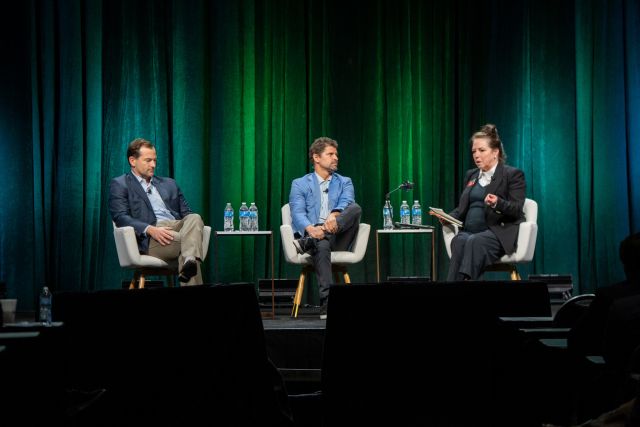
Patrick McWilliams (left), partner at NGP; Billy Quinn (middle), managing partner at Pearl Energy Investments; Nissa Darbonne (right), Editor-At-Large, Hart Energy (Source: Hart Energy)
MIDLAND, Texas — Compared to 15 years ago, when investors were throwing money at companies working in shale plays, the current criteria for winning financial backing is much higher.
But plenty of money is there for “really good teams,” speakers said during the ‘In the Money: The Next Investments’ panel at Hart Energy’s 2023 Executive Oil Conference and Exhibition on Nov. 16.
From the mid-1990s to early 2000s, “you raised money a little bit from private equity, but there was a lot of friends and family money,” Billy Quinn, managing partner at Pearl Energy Investments, said.
Then interest in the oil patch ballooned.
“By the time we got to what, 2014, 2015, you had every New York investment firm in the business and a lot of new entrants to energy private equity,” he said, adding that number of firms is now about half. “On the dollar side, more than half of the money has gone away, but there's plenty of capital available for really, really good teams with good ideas. It's just the bar. I would say the bar is much higher.”
Patrick McWilliams, partner at NGP, agreed.
“Everything kind of got smaller and a little bit tighter, and so where we find ourselves today is this concept of capital scarcity. I think there's capital scarcity in certain situations,” he said, but “if it's the right opportunity, if it's the right team, if it's the right deal, there is capital that is available.”
Quinn said he’s seen management teams that didn’t deserve to get backing receive it, but then returns went down and capital left the business.
“I think now we feel like we're in a healthy state, that really good teams who will be difference-makers in the business are getting backing, and we see that time and time again,” he said.
McWilliams said some teams are led by entrepreneurs “convicted in their ideas” who want to create something, while others are “kind of running away from something. I don’t like my current situation, maybe I can go raise capital.”
But, he said, the latter are fewer in a world with less capital available.
At the same time, the Permian is competitive and an amazing resource that “keeps trying to figure out ways to regenerate itself,” he said. “We've figured out a lot of different ways to put capital to work if it's upstream operated through non-op, through minerals royalties, we've built water businesses gathering and processing. So the Permian has a lot of different ways to play it.”
The way some deals in the past were put together didn’t always make sense, Quinn said.
“We don't see deals now where people are buying assets, or buying acreage where we look at it, and it makes no sense. And we've seen that in past markets - 2011, 2012 up through 2014—you’d see people pay dollar prices for assets and you couldn't justify them,” he said. “You try to put the math together, and it didn't make sense.”
But today, most of the time, he said, “you can understand why the person who bought them, why they paid the price.”
McWilliams said that while investment firms compete against each other, there might not be as much competition as one would think.
“Everybody's a little stylistically different. The fundamental ways with which we underwrite deals, how we look at risk and our cultures are all different,” he said. “How do you look at the world? How do you see risk? How do you see return? Why do you do what you do every day, and how do you interact with people? There's pretty material differentiation along the way. So I don't see it as a lot of competition directly, and I actually see there's going to be opportunities to partner” because those partnerships can deliver a competitive advantage.
Quinn said he prefers a capital-constrained environment.
“It sounds bad, but it just makes getting dollars out the door at reasonable values much easier. It makes the fundraising process harder,” he said.
As to where investments may go in the future, McWilliams said NGP is shale-, commodity- and basin-agnostic.
“We’re focused on returns,” he said.
He’s also not worrying about the future of the oil and gas industry.
“I'm absolutely not worried about oil and gas having a terminal value. I mean, we look at where demand is right now, somewhere between 101MMbbl/d and 102 MMbbl/d, and it’s growing. We know that this is a hydrocarbon-based economy, and that making good solid investments in this space for a long time makes a lot of sense. So I'm not worried about that over the next 30 years.”
Recommended Reading
Galp Seeks to Sell Stake in Namibia Oilfield After Discovery, Sources Say
2024-04-22 - Portuguese oil company Galp Energia has launched the sale of half of its stake in an exploration block offshore Namibia.
Deepwater Roundup 2024: Offshore Australasia, Surrounding Areas
2024-04-09 - Projects in Australia and Asia are progressing in part two of Hart Energy's 2024 Deepwater Roundup. Deepwater projects in Vietnam and Australia look to yield high reserves, while a project offshore Malaysia looks to will be developed by an solar panel powered FPSO.
Texas Earthquake Could Further Restrict Oil Companies' Saltwater Disposal Options
2024-04-12 - The quake was the largest yet in the Stanton Seismic Response Area in the Permian Basin, where regulators were already monitoring seismic activity linked to disposal of saltwater, a natural byproduct of oil and gas production.
US Raises Crude Production Growth Forecast for 2024
2024-03-12 - U.S. crude oil production will rise by 260,000 bbl/d to 13.19 MMbbl/d this year, the EIA said in its Short-Term Energy Outlook.
NAPE: Chevron’s Chris Powers Talks Traditional Oil, Gas Role in CCUS
2024-02-12 - Policy, innovation and partnership are among the areas needed to help grow the emerging CCUS sector, a Chevron executive said.



